- Description and Species
- Composition
- Positive effect on the body
- Application in folk medicine. Recipes
- Contraindications and side effects
Goldenrod( Solidágo) is a genus of herbaceous perennials from the family Srednotsvetnykh. Many of its representatives are medicinal plants, hence the scientific name of the whole genus: "solidus" in Latin means healthy. And today we want to tell you about the tremendous properties of this natural gift, as well as how to apply it correctly, so as not to harm your health.
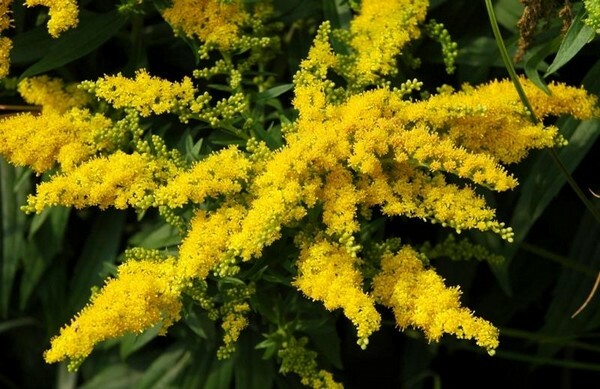
. Description and types of
The genus of plants called goldenrod includes several species, and further we will look at the photo and description of the most common ones.
The Highest
Goldenrod is the highest native of North America. It can be found in desert areas, on the prairies among tall grassy thickets, in forest glades and wet meadows, and on roadside roadsides. And despite the fact that plants belonging to this species, in the bulk of it grow in wooded areas, to shady areas they are intolerant.
You can find the highest goldenrod on the pubescent straight stems and whole simple foliage. The height of the stem can reach 1.8 m. Inflorescences are painted in lemon yellow color, have the form of baskets, which consist of small( about 2-3 mm) flowers collected in brushes. The length of one such inflorescence is approximately 35 cm. The flowering period is in August and lasts about a month and a half.
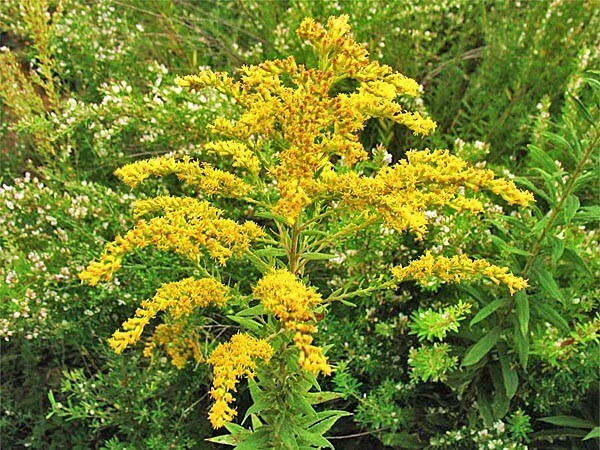
Hybrid
Goldenrod hybrid is a species that unites a rather large part of hybrid varieties. And the main among them is the Canadian goldenrod, whose native land is also considered North America.
Canadian goldenrod is a herbaceous perennial plant, whose stem can reach 2 m in height. It is not completely exhausted, but only 2/3, the lower part at the base is bare. Leaves are green, oblong-lanceolate. Numerous baskets are collected in panicles, their size is about 35 cm.
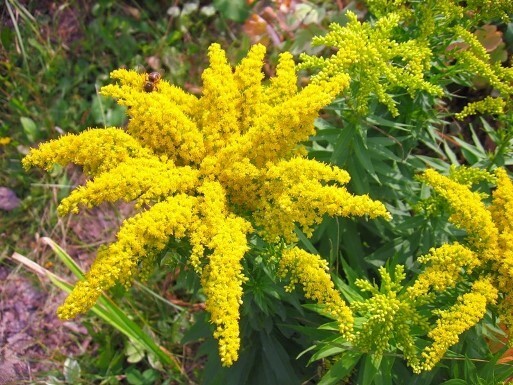
Daursky
The Dahurian goldenrod's motherland is Siberia. Detect the plant of this species can be in meadows and forests, as well as on stony slopes and gravel.
In height this plant hardly reaches 1 m. Its stalk is simple, strong, only the inflorescence is branched. Stem leaves have short petioles, and located in the basal region - petioles are long. The leaf plate can be oblong, lanceolate, or ovoid.
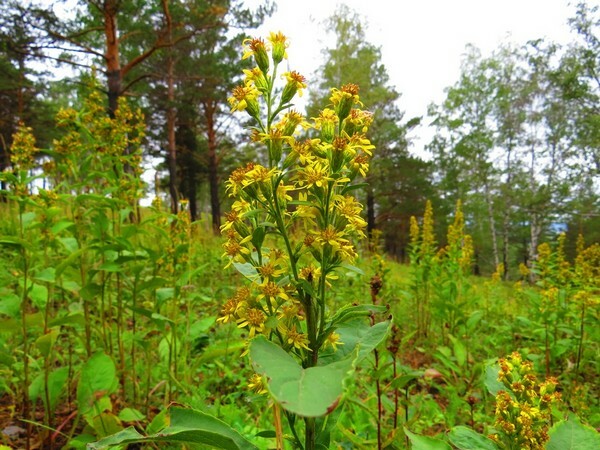
Wrinkled
Golden throat wrinkled is another native of North America. You can find it in the swampy terrain, in the quagmire, among the wet meadows and on the roadside.
The golden throat has a wrinkled smooth straight stalk, whose height is about 2 m. The shoots are colored reddish-brown, the creeping rhizome. The leaves are oblong-oval, there are denticles along the edges. The leaves are located throughout the stem except for the basal area.
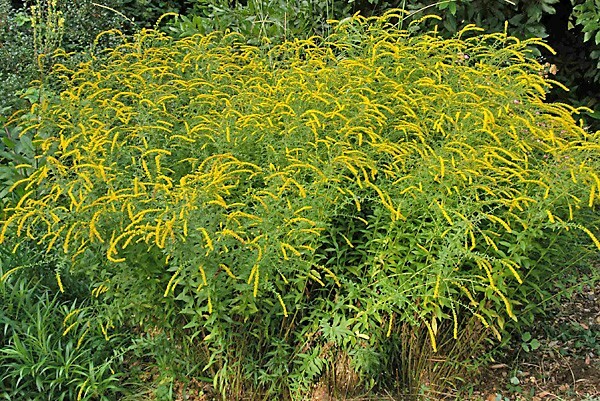
Ordinary
Solidago virgaurea, or golden branch, or golden rod, is a herbaceous perennial plant, whose height can be from 0.3 to 1 m. The stem is pubescent and ligated slightly, branched only in the upper part, can have a reddish tinge. Rhizome stems, woody and short. Leaves pointed, ovate or oval, at the edges dentate;Located in the lower part of the stem - on the petioles, in the central part and above - sessile and smaller. Inflorescences paniculate or racemose, in each several baskets consisting of small bright yellow flowers.
The flowering period of the goldenrod begins in July and lasts until September, after which fruits appear in the tops of the stems in the form of achenes with a tuft. The fruit has a cylindrical shape, ribbed. Fruit formation ends in October.
The golden rod grows on the territory of European countries, in Central Asia, Scandinavia, the Mediterranean, as well as in the Caucasus and western Siberia. It occurs in the European part of Russia.
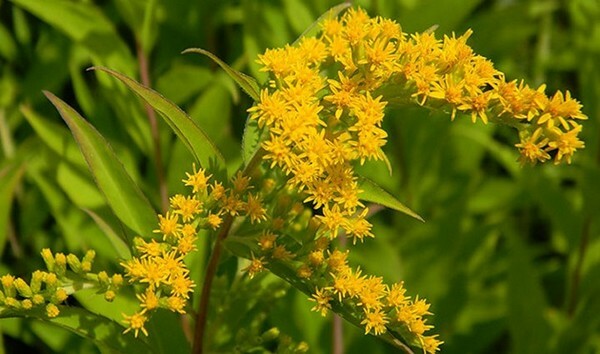
Goldenrod is famous for its useful properties. As a medicinal raw material is its overground part: more often the upper parts of the stems, leaves and inflorescences, less often - rhizomes.
Good to know! Prepare the grass during the flowering period of the plant - from July to September, the rhizomes are collected only in autumn. Dry, gathering in bundles and hung in the shade or in a draft. Ready-to-use raw materials have a bitter taste and a pronounced spicy flavor.
Composition of
To date, the medicinal properties of the goldenrod have not been fully studied, but at the same time a lot of things have been established. And the information on the chemical composition of this plant contributed to this.
Grass includes:
- flavonoids - rutin, camperol, quercetin, etc.; Acids - organic, ascorbic, nicotinic, phenolcarbonic acid;
- tanning agents;
- bitterness;
- saponins;
- coumarins;
- essential oils;
- traces of alkaloids;
- resins.
Positive effect on the body
The golden rod with proper use can bring great benefits. Among the properties of this herb:
- wound-healing;
- antibacterial;
- is a diuretic;
- choleretic;
- is an analgesic;
- is an anti-inflammatory;
- astringent;
- expectorant;
- restorative.
Thus, the use of goldenrod may be justified in the treatment of various diseases. So, this herb helps to clear the lungs of phlegm and thus relieve a coughing attack with bronchitis. With the help of preparations of this plant, it is also possible to significantly ease the condition with asthma and contribute to an early recovery in pulmonary tuberculosis.
Grass of the golden rod shows very good results in the treatment of inflammatory processes of the gallbladder, as well as with bile stagnation. And the pain syndrome with such conditions is removed already on the first day of therapy. In addition, funds on the basis of the goldenrod are often prescribed, when it is necessary to remove sand from the kidneys, to remove puffiness, to cure involuntary urination and pyelonephritis. In conditions associated with kidney and gallbladder dysfunction, alcoholic tincture is usually used. Also, the preparations of the goldenrod show a rather high effectiveness in swelling, which arose against the background of heart diseases.
Note! Preparations of the goldenrod are so good at removing excess fluid from the body that often indications for their application are such complex conditions as swelling of the internal organs and even the brain!

Goldenrod may be very useful in diabetes mellitus. It improves the course of metabolic processes and helps normalize blood glucose levels. And this is its property can be used not only in diabetes, but also simply when there is a hanging of sugar.
The healing properties of the golden throat become actual in digestive disorders. Due to its astringent action, herbal preparations quickly stop diarrhea, and at the same time the cause that caused this problem is eliminated. As a result, pathogens die, and overall well-being improves markedly.
Grass of the golden rod has found wide application as a wound-healing agent. With its help you can prevent the risk of infection of the damaged area and accelerate the regeneration of the skin. In addition, its drugs are excellent even with purulent wounds and ulcers - they quickly clean, remove purulent masses and tighten the wound. Direct indications in this case can be such dermatological problems as psoriasis and eczema, as well as furunculosis.
Note! In the latter case, the leaves of the goldenrod are usually applied - they are soaked in pure water and applied for a time to the affected area!
Quite good results goldenrod show in the treatment of respiratory infections, herpes and influenza. It helps to reduce the intensity of symptoms, relieves tonsillitis, laryngitis and stomatitis. When you take funds based on this plant noticeably quickly improves the general condition, normalizes the appetite and stimulates metabolism.

. Application in folk medicine. Recipes
In different cases, the grass of the golden rod will have a different application. For example, inside it is taken in the form of tea, tincture or decoction, it is also possible to use the extract. As for external therapy, it will already need compresses and lotions.
- From edema, with dropsy, pyelonephritis, pulmonary tuberculosis, asthma. In this case, use the infusion of herbs, which are prepared according to the following recipe: 2 tablespoons of dried raw material should be poured with two glasses of steep boiling water and left for 3-4 hours. After this time, the filter is filtered. We take ready infusion of 50 ml three times a day before meals.
Note! This infusion can also be used for rinses to treat sore throats and stomatitis!
- With gout. We brew such a remedy: in a container mix 50 grams of goldenrod, flowers of black elderberry and herb St. John's wort, add 60 g of linden flowers heart-shaped. Separate a tablespoon of dry mixture and pour a glass( 250 ml) of steep boiling water. We insist and filter. We take 250 ml twice a day.
- With nephrolithiasis. We prepare the broth: pour a tablespoon of herbs of golden rod with a glass of boiling water and cook on small fire for about 4-5 minutes. We remove the decoction from the plate and leave it for a couple of hours. Filter the product and take 2 tablespoons three times a day.
- With chronic nephritis. To treat this disease, you need to prepare this drug: 2 tablespoons of dry herbs of goldenrod pour half a liter of steep boiling water and cook on a water bath for 10 minutes. We remove the broth from the fire, filter it. Drink a remedy 4 times a day for half a glass( 100ml).
- For rinsing the mouth and for removing inflammation of various origins. A tablespoon of herb grass should be stewed in 200 ml of steep boiling water. After one hour, the medium is filtered and used externally.
- For the treatment of purulent wounds, furunculosis, abscesses of the gums, with angina and infectious diseases of the respiratory tract. A tablespoon of goldenrod ordinary pour 250 ml of boiling water and insist for 2 hours. After this time, the preparation is filtered and used in the form of compresses, rinses and for washing.
- Decoction for baths, which is indicated for skin rashes, eczema, psoriasis, skin tuberculosis. On a bucket of water( 10 liters), add 50 g of dried raw materials and bring to a boil. Cook for a quarter of an hour, then leave at room temperature for 2 hours. Add the ready-made decoction to the bath - the water temperature in the bathroom should be about +38. .. 40 ° C.
- Tea. For 400 ml of cold water, add 2 teaspoons of herbs of golden rod, set on fire and bring to a boil. Leave for a few minutes, if desired, filter.
Contraindications and side effects
The gold rod is capable of exhibiting very powerful medicinal properties, but since some toxic substances have been found in its composition, it also has certain contraindications.
- First of all it concerns the period of pregnancy and lactation.
- In addition, it is prohibited to take preparations of this plant with glomerulonephritis in both acute and chronic forms.
- To direct contraindications include allergic reactions and individual intolerance.
Admission of any means of goldenrod must be agreed with the attending physician. At the same time, it is always necessary to observe the prescribed dosages and in no case exceed the daily norm. When an overdose, the appearance of protein and blood in the urine.
Use the gifts of nature competently and stay healthy!
